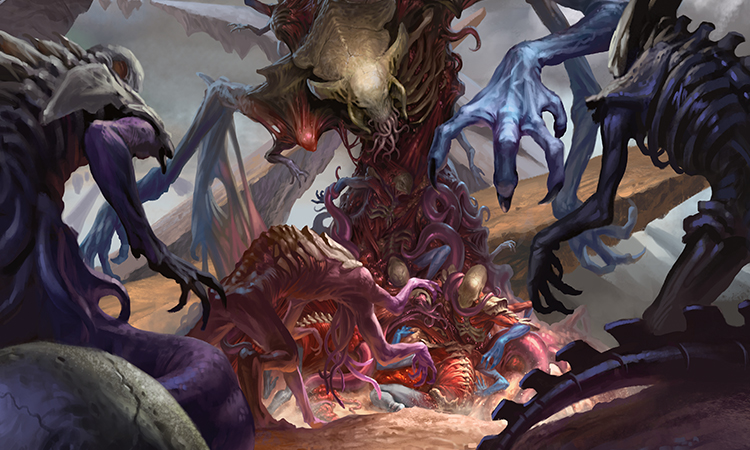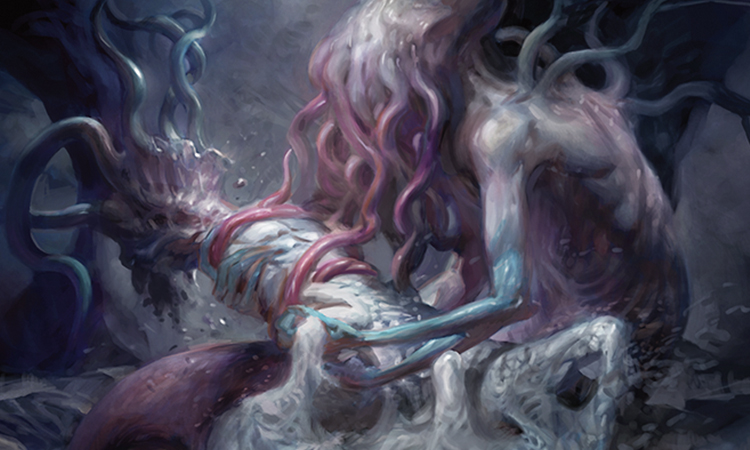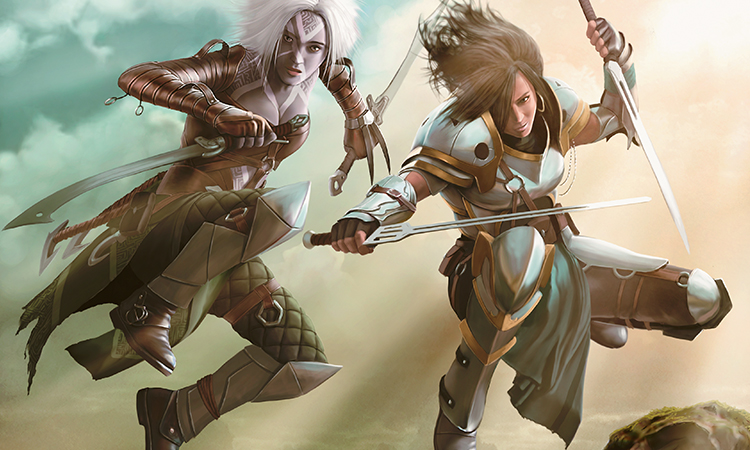Battle Plans
Welcome to Zendikari vs. Eldrazi Week! This week we're going to be talking about all the major conflicts of Battle for Zendikar block. I've decided my column would be a good place to examine how we design a two-sided conflict. I will, of course, be using Battle for Zendikar for my examples.
This Means War
So let me begin by defining what I mean when I say "a two-sided conflict." It means there's a story where there are two clearly identified factions that are each uniquely separated from the other and that directly oppose one another through some form of fighting. In Battle for Zendikar, those two factions are the Eldrazi and the Zendikari. Each is very different from the other, and the two have conflicting desires. The Eldrazi want to eat the world of Zendikar, while the Zendikari do not want that to happen. To save their world, the Zendikari must stop the Eldrazi—thus creating conflict.
Now, Magic is all about conflict, so almost any story will involve different elements of a world fighting one another. What makes a two-sided conflict unique is that (almost) every card in the set is identified as being a member of one of two factions. This means that the design is responsible for establishing and reinforcing this conflict. Here are the five things you have to do in the design of a two-sided conflict:
1. Mechanically Define Each Side
The first thing you have to do is create a mechanical identity for each of your two factions. The best way to do this is to figure out what you want each faction to represent. With Battle for Zendikar, the two factions already existed, so it was less about creating an identity and more about figuring out how to use mechanics to reinforce the identities they already had.
Usually the trick I use is to start by choosing words that describe the faction. For instance, for the Eldrazi, I defined them with five traits:
- Ancient: The Eldrazi are some of the oldest creatures in existence.
- Enormous: The Eldrazi are physically very large.
- Alien: One of the biggest threats of the Eldrazi is that they are so unfathomable they cannot be reasoned with, and their plans cannot be predicted because they cannot be understood by any normal thought process.
- Interconnected: The Eldrazi have some strange connection to one another; they are not separate entities but rather components of a larger whole that all work together.
- Hungry: The Eldrazi, and Ulamog in particular, have a voraciousness that cannot be quenched. They will eat a plane until it is gone.
Having these traits allows my design team to then assign mechanics and mechanical themes that express these attributes. For example, here's how the Eldrazi's five attributes played out mechanically:
- Ancient: The colorlessness represents how old the Eldrazi are, as they predate colored mana.
- Enormous: The Eldrazi, especially the more central ones, have high power and toughness.
- Alien: Ingest and the Processors have them messing around with the exile zone, something we don't normally do.
- Interconnected: The Scions help get out the larger Eldrazi, while all the exiling helps feed the Processors.
- Hungry: The Eldrazi do a lot of exiling, which represents their endless hunger.

Vile Aggregate | Art by Chris Rallis
For the Zendikari, we did a similar exercise:
- Desperate: When we start up our story, things have gone very badly for the Zendikari, and they realize that if they don't stop the Eldrazi, their world is doomed.
- Relentless: The Zendikari have nothing to lose, so they are giving this fight their all.
- Working Together: Despite their differences, the Zendikari have to band together against a common enemy.
- Small: In comparison to the Eldrazi, the Zendikari are tiny.
- Connected to the Land: One of the few advantages the Zendikari have is that they have a strong tie to their world. Luckily, as we learned last time we visited, the land of Zendikar is sentient.
And then we found mechanical ways to express them:
- Desperate: The Zendikari are designed to be faster.
- Relentless: The Zendikari are more aggressive and make use of landfall, which encourages attacking.
- Working Together: The Zendikari have the rally mechanic, which makes you want to play many Allies together.
- Small: The Zendikari are significantly smaller than the Eldrazi.
- Connected to the Land: The Zendikari have access to both landfall and awaken, which create synergy with lands.
By going through this exercise, you are able to create factions that mechanically play in a way that reinforces their flavor.
Usually, this technique makes you split the mechanics between factions. For example, each mechanic in Battle for Zendikar is either an Eldrazi mechanic or a Zendikari mechanic. None of them cross over. It is possible, though, to create a mechanic that crosses over both factions, but you need to find a way to differentiate how each faction uses it. A good example might be morph. Khans of Tarkir had five factions, not two, but morph was a mechanic that got used by all the factions. How they used morph was one of the ways we differentiated them.
2. Create Mechanical Synergy Within Each Faction
Once you have your factions, the next thing you need to do is figure out how to make the mechanical elements of that faction work together. One of the important ways to make a faction feel connected is to make sure that the components of that faction have mechanical synergy. Let's take a look at the two factions in Battle for Zendikar.
The key to mechanical cohesion for the Eldrazi was making sure that every Eldrazi was either a threat or a card that helps enable the threats. For instance, the Eldrazi have a lot of big, threatening creatures. The Eldrazi Scion creature tokens were included because they do two important things. First, they can provide colorless mana to help cast the expensive Eldrazi, and second, they can be used defensively to chump block threats, allowing you to stay alive long enough to get your larger Eldrazi onto the battlefield. Likewise, we used exiling as a way to represent the Eldrazi eating things and then created a series of creatures, the Processors, that allowed you to take advantage of that resource.

Incubator Drone | Art by Cynthia Sheppard
On the Zendikari side, we pushed a more aggressive agenda. The Zendikari tend to be smaller and thus cheaper to cast. Both landfall and the rally mechanic are used to help encourage attacking. Rally pushes you to go wider in color to get more Allies, which then makes your deck a better fit for converge. Meanwhile, the land-centric mechanics tend to get more land into play, which allows you to have both the mana and the target for the awaken spells.
It's important to remember that some players like to play along with the story you're presenting. If you offer up two sides, they will be encouraged to pick one of the sides and then play it. You want to make sure that each faction provides a clear message of what it does and then has the support to allow the player who pursues it to get the gameplay experience they expect.
3. Create Contrast Between the Sides
Once you have the two sides and each one has an identity, the next step is to start figuring out what the relationship is between the two sides. Normally, this is done through some kind of mechanical contrast. Obviously, the two factions have to feel different. This step says that those differences should be thought of in contrast with one another.
For instance, we created an identity that the Eldrazi are big and slow. That helped us shape the Zendikari to be the opposite—they are small and fast. This relationship helped us start to map out the gameplay for the set. The Eldrazi take the role of the control side. They are threatening but take time to establish themselves. The Zendikari take the role of the aggro side. They are fast but run out of steam. This contrast allows us to help convey the essence of the conflict through gameplay.
Usually you will have more than one contrast, because you want each side to have various facets. Another contrast between the Eldrazi and the Zendikari is how they handle color. All the Eldrazi are colorless (either what R&D refers to as "true colorless"—having a generic mana cost—or devoid). They also have a strong theme of caring about colorlessness. The Zendikari, in contrast, care about color. This is represented both through the converge mechanic and the fact that the Zendikari mechanics often encourage you to spread out in extra colors.
It's important that your audience understands what each faction represents and why the two are in conflict. Having this conflict reinforced through gameplay helps make it clear to the players why and how the two sides are in conflict.
4. Make Sure Each Side Has the Tools to Battle the Other Side
Once you have a mechanical contrast, the next step is making sure that each side has the necessary tools to deal with the opposing side. If one side has a strategy that cannot be handled by their enemy, the gameplay will suffer, as players will all drift towards the side that wins. There are two ways to handle this, what I'll call the macro solution and the micro solution. For good design, you want both.
The macro solution is making sure that each side's strategy has vulnerabilities to the other side. The Eldrazi, for instance, want a slow-building deck that works to establish control in the game. Built into that model is an inherent vulnerability: The deck needs to stabilize, meaning it's vulnerable to a quick counter-strategy. Conversely, the Zendikari strategy tends to rely on aggression. If the opponent is able to stall enough to get out its larger forces, the Zendikari side gets in trouble.
The macro solution is all about setting up this relationship between the strategies of each side. Each faction needs to have a route to victory as well as a vulnerability to the other side's strategy. This guarantees that there is a dynamic relationship.
The micro solution is about making sure that each faction has individual cards that specifically work against the other side. For example, the Eldrazi are identified by their colorlessness. The Zendikari thus have a few cards that work well against colorless things. Meanwhile, the Zendikari are small by nature, which allows the Eldrazi to have answers that can pick off smaller creatures. The key to the micro solution is giving each faction answers to the opponent through individual cards.
It's important to remember that you are building not just two factions but a larger ecosystem for fun and interactive gameplay. That means that you have to build in not just threats but also answers.
5. Enable Players to Mix and Match Elements of Each Side
This last step is easy to miss, but it's one of the most important. Magic is a trading card game, which means that the ability to mix and match cards is crucial, so much so that you want to make sure your two factions can play nicely together. Another way of thinking about it is this: Some players will want to buy into one of the two factions and play one side or the other. Many other players, though, will just want to build the best deck possible, and the division of the two factions won't even be something they care about.
In addition, current sets have to live through a lot of repeated play, especially in Limited. If your two factions only interact among themselves, you're greatly cutting down on the amount of combinations available. This means that the final step is making sure you layer in interactions that allow inter-faction play. What makes this tricky is that you don't want the interactions being too loud, because you don't want the flavor to suggest the two different sides are working together.
Let me give you a few examples of how we accomplished this task in Battle for Zendikar. All the Eldrazi are colorless, allowing us to put a "colorlessness matters" theme in the set. All the Zendikari are colored, but we still found a way to sneak some colorlessness into the Zendikari side. How did we do it? By making use of a rule that not too many players think about. The Zendikari are allied with the land of Zendikar, so we created the awaken mechanic, which allows the Zendikari to animate the land to fight with them. But land is colorless, which means when you animate a land, you've made a colorless creature that can now be buffed by the Eldrazi "colorlessness matters" cards. This allows you to now play awaken in an Eldrazi deck.
Let's look at the flip side. The Zendikari tend to play very aggressively. As such, a Zendikari deck rewards a "go wide" strategy, where you get a lot of little creatures onto the battlefield. To take advantage of this, the Zendikari have cards that count your creatures or give buffs to the entire team. Meanwhile, the Eldrazi make 1/1 Scion creature tokens as a means to help produce mana to cast the larger Eldrazi cards. But the Eldrazi Scions at 1/1 play well into the "go wide" strategy. So just as the Eldrazi can play awaken cards, the Zendikari can play cards that create Scion creature tokens.

Tandem Tactics | Art by David Gaillet
Probably the best evidence of the importance of this step can be seen in the last two-sided conflict we did: Scars of Mirrodin block. In that block, the two sides were the Mirrans (aka the denizens of Mirrodin) and the Phyrexians (the conquering invaders). In design, I had built in crossovers. I had specifically created a lot of charge-counter artifacts and then made sure to put proliferate in at common, so that the Mirran side might want to play proliferate cards. I then wove in a strong artifact and creature-sacrificing theme in black and red, allowing you to put more artifacts into a Phyrexian deck.
Unfortunately, I did a poor job of documenting why I did these things, and they got watered down significantly during development. The end result was that the Mirran and Phyrexian sides were too segregated. This created more repetition of play, as the Mirran and Phyrexian decks tended to look similar, and caused drafting problems, because once you went far enough down one path, you got stuck having to draft that side.
Note that this final step doesn't prevent the players who want to commit to one faction from doing so, it just ensures that players who are more focused on other things aren't forced to do so as well.
Fighting the Good Fight
When we talk about archetypes in Magic, we're most often talking about specific styles of decks. Today's column wants to point out that there are also archetypes in design. Different blocks have different functions and thus have different needs when you build them. A two-sided conflict is not something we do all the time, but it's a core archetype of Magic sets, as the game is, after all, centrally about conflict. What this means is when you're putting together a design, it's important to understand what kind of set/block you are building and what structure that will dictate.
I hope you enjoyed today's column, and as always I am interested in hearing your feedback. You can write to me through my email or through any of my social media accounts (Twitter, Tumblr, Google+, Instagram).
Join me next week for a column devoid of content. I mean, for a column with the content of devoid.
Until then, may you pick a side (you know, unless you don't want to).
"Drive to Work #268—PAX 2015"
Wizards pulled out all the stops with Magic at the Penny Arcade Expo held in Seattle this past August. This podcast talks all about it, including the full tale of my crazy seventeen-hour day.
"Drive to Work #269—Breaking Rules"
Magic is a game that often breaks its own rules. Today's podcast talks about when, why, and how you should break the rules in game design.
- Episode 269 Breaking Rules (15.1 MB)
- Episode 268 PAX 2015 (20.5 MB)
- Episode 267 Green-Blue (15.3 MB)
- Episode 266 Returning to Worlds (17.4 MB)
- Episode 265 Creative Process, Part 2 (18.0 MB)

